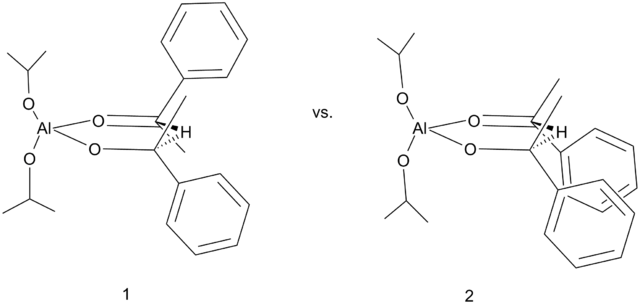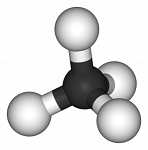Reduction with Aluminum Alkoxides (The Meerwein-Ponndorf-Verley Reduction)
- Page ID
- 66727
Meerwein–Ponndorf–Verley (MPV) reduction in organic chemistry is the reduction of ketones and aldehydes to their corresponding alcohols utilizing aluminium alkoxide catalysis in the presence of a sacrificial alcohol. The beauty of the MPV reduction lies in its high chemoselectivity, and its use of a cheap environmentally friendly metal catalyst.
Figure 1, Exchange of carbonyl oxidation states in the presence of aluminium isopropoxide.

By Lankaluf (Own work) [Public domain], via Wikimedia Commons
The MPV reduction was discovered byMeerwein and Schmidt, and separately by Verley in 1925. They found that a mixture of aluminium ethoxide and ethanol could reduce aldehydes to their alcohols. Ponndorf applied the reaction to ketones and upgraded the catalyst to aluminium isopropoxide in isopropanol.
Mechanism
The MPV reduction is believed to go through a catalytic cycle involving a six-member ring transition state as shown in Figure 2. Starting with the aluminium alkoxide 1, a carbonyl oxygen is coordinated to achieve the tetra coordinated aluminium intermediate 2. Between intermediates 2 and 3 the hydride is transferred to the carbonyl from the alkoxy ligand via a pericyclic mechanism. At this point the new carbonyl dissociates and gives the tricoordinated aluminium species 4. Finally, an alcohol from solution displaces the newly reduced carbonyl to regenerate the catalyst 1.
Figure 2, Catalytic cycle of Meerwein–Ponndorf–Verley reduction

By Jkolev (Own work) [CC BY-SA 3.0 (http://creativecommons.org/licenses/by-sa/3.0) or GFDL (http://www.gnu.org/copyleft/fdl.html)], via Wikimedia Commons
Each step in the cycle is reversible and the reaction is driven by the thermodynamic properties of the intermediates and the products. This means that given time the more thermodynamically stable product will be favored.
Several other mechanisms have been proposed for this reaction, including a radical mechanism as well as a mechanism involving an aluminium hydride species. The direct hydride transfer is the commonly accepted mechanism recently supported by experimental and theoretical data.
Chemoselectivity
One of the great draws of the Meerwein–Ponndorf–Verley reduction is its chemoselectivity. Aldehydes are reduced before ketones allowing for a measure of control over the reaction. If it is necessary to reduce one carbonyl in the presence of another, the common carbonyl protecting groups may be employed. Groups, such as alkenes and alkynes, that normally pose a problem for reduction by other means have no reactivity under these conditions.
Stereoselectivity
The aluminium based Meerwein–Ponndorf–Verley reduction can be performed on prochiral ketones leading to chiralalcohols. The three main ways to achieve the asymmetric reduction is by use of a chiral alcohol hydride source, use of an intramolecular MPV reduction, or use of a chiral ligand on the aluminium alkoxide.
One method of achieving the asymmetric MPV reduction is with the use of chiral hydride donating alcohols. The use of chiral alcohol (R)-(+)-sec-o-bromophen-ethyl alcohol gave 82% e.e. (percent enantiomeric excess) in the reduction of 2-chloroacetophenone. This enantioselection is due to the sterics of the two phenol groups in the six membered transition state as shown in Figure 3. In Figure 3, 1 is favored over 2 due to the large steric effect in 2 from the two phenyl groups.
Figure 3, Transition states of MPV reduction with a chiral alcohol

By Jkolev (Own work) [CC BY-SA 3.0 (http://creativecommons.org/licenses/by-sa/3.0) or GFDL (http://www.gnu.org/copyleft/fdl.html)], via Wikimedia Commons
The use of an intramolecular MPV reduction can give good enantiopurity. By tethering the ketone to the hydride source only one transition state is possible (Figure 4) leading to the asymmetric reduction. This method, however, has the ability to undergo the reverse Oppenauer oxidation due to the proximity of the two reagents. Thus the reaction runs under thermodynamic equilibrium with the ratio of the products related to their relative stabilities. After the reaction is run the hydride-source portion of the molecule can be removed.
Figure 4, Transition state of intramolecular MPV reduction

By Jkolev (Own work) [CC BY-SA 3.0 (http://creativecommons.org/licenses/by-sa/3.0) or GFDL (http://www.gnu.org/copyleft/fdl.html)], via Wikimedia Commons
Chiral ligands on the aluminium alkoxide can affect the stereochemical outcome of the MPV reduction. This method lead to the reduction of substituted acetophenones in up to 83% e.e. (Figure 5). The appeal of this method is that it uses a chiral ligand as opposed to a stoiciometric source of chirality. It has been recently shown that the low selectivity of this method is due to the shape of the transition state. It has been shown that the transition state is a planar six member transition state. This is different than the believed Zimmerman-Traxler model like transition state.

By Jkolev (Own work) [CC BY-SA 3.0 (http://creativecommons.org/licenses/by-sa/3.0) or GFDL (http://www.gnu.org/copyleft/fdl.html)], via Wikimedia Commons
Scope
Several problems restrict the use of the Meerwein–Ponndorf–Verley reduction compared to the use of other reducing agents. The stereochemical control is seriously limited. Often a large amount of aluminium alkoxide is needed when using commercial reagent, and there are several known side reactions.
While commercial aluminim isopropoxide is available, the use of it often requires catalyst loadings of up to 100-200 mol%. This hinders the use of the MPV reduction on scale. Recent work has shown that aluminium alkoxides made in situ from trimethyl aluminium reagents have far better activity requiring as little as 10% loading. The activity difference is believed to be due to the large aggregation state of the commercially available product.
Several side reactions are known to occur. In the case of ketones and especially aldehydes aldol condensations have been observed. Aldehydes with no α-hydrogens can undergo the Tishchenko reaction. Finally, in some cases the alcohol generated by the reduction can be dehydrated giving an alkyl carbon.
Variations
The Meerwein–Ponndorf–Verley reduction has been recently used in the synthesis of chiral amines from ketimines using a chiral alkoxide. The addition of a phosphinoyl group to the nitrogen of the ketimine allowed for high enantioselectivity up to 98% e.e.
Work has been done in the use of lanthanides and transition metals for the Meerwein–Ponndorf–Verley reduction. Both Ruthenium and Samarium have shown high yields and high stereoselectivity in the reduction of carbonyls to alcohols. The Ruthenium catalyst has been shown, however, to go through a Ruthenium hydride intermediate. The Meerwein–Ponndorf–Verley reduction has also been effected with synthetically useful yield by plutonium (III) isopropoxide.
The standard MPV reduction is a homogeneous reaction several heterogeneous reactions have been developed.
See also
- Oppenauer oxidation
- Carbonyl reduction
References
- Wilds, A. L. Org. React. 1944, 2.
- Meerwein, Hans; Schmidt, Rudolf (1925). "Ein neues Verfahren zur Reduktion von Aldehyden und Ketonen". Justus Liebigs Annalen der Chemie. 444 (1): 221–238. doi:10.1002/jlac.19254440112.
- Verley, A., (1925). Bull. Soc. Chim. Fr. 37: 537. Missing or empty |title= (help)
- Wolfgang Ponndorf (1926). "Der reversible Austausch der Oxydationsstufen zwischen Aldehyden oder Ketonen einerseits und primären oder sekundären Alkoholen anderseits". Angewandte Chemie. 39 (5): 138–143. doi:10.1002/ange.19260390504.
- R. Cohen;C. R. Graves; S. T. Nguyen, J. M. L. Martin; M. A. Ratner (2004). "The Mechanism of Aluminum-Catalyzed Meerwein-Schmidt-Ponndorf-Verley Reduction of Carbonyls to alcohols". Journal of the American Chemical Society. 126 (45): 14796–14803. doi:10.1021/ja047613m.
- De Graauw, C. F.; Peters, J. A.; Van Bekkum, H.; Huskens, J. (1994). "Meerwein-Ponndorf-Verley Reductions and Oppenauer Oxidations: An Integrated Approach". Synthesis. 1994 (10): 1007. doi:10.1055/s-1994-25625.
- T. Ooi; T. Miura; K. Marouka (1998). "Highly Efficient, Catalytic Meerwein–Ponndorf–Verler Reduction with a Novel Bidentate Aluminum Catalyst". Angew. Chem. Int. Ed. 37 (17): 2347–2349. doi:10.1002/(SICI)1521-3773(19980918)37:17<2347::AID-ANIE2347>3.0.CO;2-U.
- M. Fujita; Y. Takarada; T. Sugimura, A. Tai (1997). "Reliable chiral transfer through thermodynamic equilibrium of the intramolecular Meerwein–Ponndorf–Verley reduction and Oppenauer oxidation". Chemical Communications (17): 1631–1632. doi:10.1039/A704341D.
- E. J. Campbell; H. Zhou; S. T. Nguyen (2002). "The Asymmetric Meerwein-Schmidt-Ponndorf-Verley Reduction of Prochiral Ketones with iPrOH Catalyzed by Al Catalysts". Angew. Chem. Int. Ed. 41 (6): 1020–1022. doi:10.1002/1521-3773(20020315)41:6<1020::AID-ANIE1020>3.0.CO;2-S.
- E. J. Campbell; H. Zhou; S. T. Nguyen (2001). "Catalytic Meerwein-Pondorf-Verley Reduction by Simple Aluminum Complexes". Organic Letters. 3 (15): 2391–2393. doi:10.1021/ol0162116.
- C. R. Graves; K. A. Scheidt; S. T. Nguyen (2006). "Enantioselective MSPV Reduction of Ketimines Using 2-propanol and (BINOL)AlIII". Organic Letters. 8 (6): 1229–1232. doi:10.1021/ol060110w.
- D. A. Evans; S. G. Nelson; M. R. Gagne; A. R. Muci (1993). "A Chiral Samarium-Based Catalyst for the Asymmetric Meerwein–Ponndorf–Verley Reduction". Journal of the American Chemical Society. 115 (21): 9800–9801. doi:10.1021/ja00074a057.
- K. Haack; S. Hashiguchi; A. Fujii; T. Ikariya; R. Noyori (1997). "The Catalyst Precursor, Catalyst, and Intermediate in the RuII-Promoted Asymmetric Hydrogen Transfer between alcohols and Ketones". Angew. Chem. Int. Ed. Engl. 36 (3): 285–288. doi:10.1002/anie.199702851.
- Benjamin P. Warner, Joseph A. D’Alessio, Arthur N. Morgan III; d'Alessio; Morgan; Burns; Schake; Watkin (2000). "Plutonium(III)-catalyzed Meerwein –Ponndorf –Verley reactions". Inorganica Chimica Acta. 309 (1–2): 45–48. doi:10.1016/S0020-1693(00)00227-9.
- G.K. Chuah; S. Jaenicke; Y.Z. Zhu; S.H. Liu (2006). "Meerwein–Ponndorf–Verley reduction over Heterogeneous Catalysts". Current Organic Chemistry. 10 (13): 1639–1654. doi:10.2174/138527206778249621
Contributors
- Wikipedia (CC-BY-SA-3.0)


